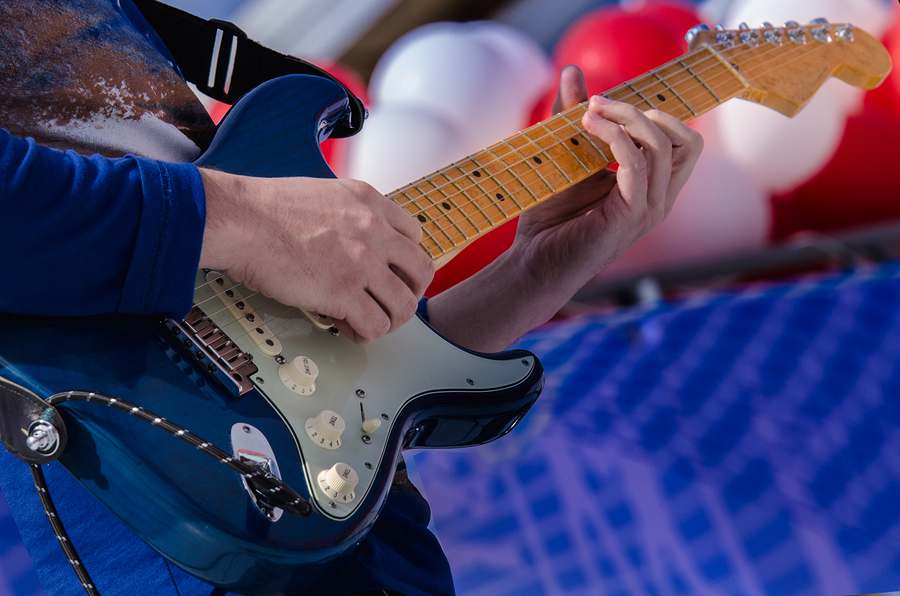May 15, 2019 by Klaus Crow
Photo by Bigstock photo
 The harmonic minor scale is often used in neo-classical, gypsy and jazz music.
The harmonic minor scale is often used in neo-classical, gypsy and jazz music.
But also rock guitar players like to step outside of the pentatonic or minor scale now and then and add this kind of middle eastern sound to their solos to keep things interesting.
It really catches the ear of the listener because something different and exciting is happening. John Petrucci, Joe Satriani and Marty Friedman are good examples of guitar players who incorporate the harmonic minor tastefully into their solos.
If you’re ready to add some cool flavor to play over a minor chord or dominant seventh chord then let’s dive into it:
Formulas
The harmonic minor scale contains 7 notes. The scale formula = 1 2 b3 4 5 b6 7. So compared to the major scale (1 2 3 4 5 6 7) it’s got a minor third and a minor sixth.
The harmonic minor scale and the natural minor scale (1 2 b3 4 5 b6 b7) are pretty much the same expect the harmonic minor has raised it’s 7th by one semitone.
If you play an harmonic minor scale on a single string the pattern of whole and half steps are:
“whole, half, whole, whole, half, whole & a half, half”.
(half step = 1 fret, whole step = 2 frets, whole & a half = 3 frets)
So the formula in semitones = 2 1 2 2 1 3 1
Here’s how you play an A harmonic minor scale. The root note starting on the 6th string (Low E-string)
Here’s the harmonic minor scale starting on the 5th string (A-string): D harmonic minor scale.
The chords
Just like the major scale you can build chords of the harmonic minor scale. If you stack a third and a fifth on top of each scale degree of the harmonic minor scale you get seven chords that you can use for accompaniment to support your soloing.
Here’s the formula for finding chords in a harmonic minor scale:
1=minor, 2=diminished, b3=augmented, 4=minor, 5=major, b6=major, 7=dim.
So if your playing in the key of A, you get the following chords:
Am – Bdim – Caug – Dm – E – F – G#dim.
We can also stack another third on top of each scale degree (3rd,5th and 7th) to extend the chords.
We get the following formula:
1=minorMaj7, 2=minor7b5, b3=Maj7#5, 4=minor7, 5=dom7, b6=Maj7, 7=dim7.
So if your playing in the key of A, you get the following chords:
AmMaj7 – Bm7b5 – CMaj7#5 – Dm7 – E7 – FMaj7 – G#dim7.
These are not all chords that you will use in main stream pop, blues or rock music, but a common progression is i-iv-V7. In the key of A that would be: Am – Dm – E7.
An example for jazz is a iim7b5-V7-i chord progression. In the key of A that is: Bm7b5 – E7 – Am
You’re free to create your own combinations.
Applying the scale
The harmonic minor scale can be played over a minor chord, so if you’re playing a song or chord progression in the key of A minor you can use the A harmonic minor scale. Playing a song in Em? Use the E harmonic minor scale and so on.
Dominant seventh
You can also apply the harmonic minor scale over a dominant 7th chord (V7). The V7 (five-seventh) chord is built on the 5th degree of the scale (also known as the dominant), that means if you want to use the harmonic minor scale over (let’s say) an E7 chord you’ve got to play A harmonic minor, because E is the fifth of A.
Let’s give you another example. If you want to use the harmonic minor scale over a C7 chord you have to play F harmonic minor (C is the fifth of F).
Another simple approach for those who are not familiar with music theory: Harmonic minor scale over a D7 chord? Go up 5 half steps (frets) from D = G and play G harmonic minor.
Harmonic minor exercises:
– Practice each scale ascending and descending using alternate picking technique.
– Practice each scale in all keys starting on the 1st fret, each time moving up a half step all the way up to the 12th fret and back again.
– Play the scale ascending starting on the 2nd fret, then go up a half step and play the scale descending, go up a half step and play it ascending, up a half step and play the scale descending and so on. All the way up the 12th fret and then all way back again.
– A challenging exercise is to combine both harmonic minor scale and natural minor scale in one exercise: Play the harmonic minor scale ascending and then the natural minor scale descending, then go up a half step and play the natural minor scale ascending and the harmonic minor scale descending, go up a half step and play the harmonic minor scale ascending and then the natural minor scale descending, and so on. All the way to the 12th fret and back again.
– Learn to create and combine melody from the harmonic minor, natural minor and the minor pentatonic scale tastefully into your solos and improvisation.
– Develop your aural skills. Try to sing the harmonic minor scale ascending and descending and then sing the natural minor scale ascending and descending. If you got that down, sing the harmonic minor scale each time up a half step ascending and descending or even more challenging, sing it ascending and then up a half step descending, up a half step ascending, up a half step descending. This is really good ear training stuff to learn to recognize scale notes and analyzing melody.
Note: Practice your scales in different keys to really master them inside out. It will really pay off.
Be awesome!
Join the Guitarhabits facebook page to keep up with the latest posts, guitar lesson videos, tips, tricks and other news about Guitarhabits.



Hi klaus sir,
I am a beginner.I decided to practice these scales.This article gives me the basic knowledge about scales.This site is informative for all guitarist.I’m glad that I learned to play guitar from you.you are rocking.thank you for sharing
Hi Prasana,
If you’re a beginner, it’s best you focus on the pentatonic / blues, major and minor scale. See archive.
But if you’re curious and a fast learner you can always try something new and pick up a few things. That doesn’t hurt anyone. It is a beautiful scale after all :)
Best regards,
Klaus Crow
This is a great article. I’m a very basic beginner who’s just noodling on an old gutar that was lying around the house. The first thing i started practicing from your blog was the blues/pentatonic scales, which feel like great excercises, but this scale, for whatever reason, i seem to be able to make sound much better and it doesn’t take long to feel an improvement in your playing which is a much needed confidence boost for someone that can’t make very many pleasant noises with a guitar. It has a great spanish guitar kind of sound. Fantastic explanation video. Thanks so much for putting in the time and effort to share your expertise. Looking forward to improveming my guitar skills and hopefully investing in some quality instruments myself. I’ve always liked the idea of creating my own music and your blog’s helping to show me the baby steps i need to take to make that idea become a reality.
Hi Alex,
Thanks.
I can imagine playing just pentatonic scales doesn’t really feel like melodic playing. If you really want to get melodic with the pentatonic/blues scale check out the 50coolblueslicksimprovisation” course.
Have fun!
Best regards,
Klaus Crow
One of my favorite scales! Especially for soloing I really love the harmonic minor scale. You do a great job explaining the theory behind the scale as well. Understanding not only the formula but what it all means is critical. Without that understanding you’ll be in the dark as soon as you’re asked to change key! I’m sure this post will be very helpful to many guitarists. Thanks for sharing!
Great example, listen to Steve Hackett, old Genesis, “firth of fifth” a classic guitar solo which is “epic..” He still plays this today.. every guitarist should listen to that song. Now that’s the awesomeness of Harmonic Minor solo!! Album: Selling England By the Pound/Genesis
Do you have this information the other modes:
“Here’s the formula for finding chords in a harmonic minor scale:
1=minor, 2=diminished, b3=augmented, 4=minor, 5=major, b6=major, 7=dim.
So if your playing in the key of A, you get the following chords:
Am – Bdim – Caug – Dm – E – F – G#dim.
We can also stack another third on top of each scale degree (3rd,5th and 7th) to extend the chords.
We get the following formula:
1=minorMaj7, 2=minor7b5, b3=Maj7#5, 4=minor7, 5=dom7, b6=Maj7, 7=dim7.
So if your playing in the key of A, you get the following chords:
AmMaj7 – Bm7b5 – CMaj7#5 – Dm7 – E7 – FMaj7 – G#dim7.”
Very easy and informative, thank you, I look forward to seeing more.
Thank you :)
I am so glad to learn other ways to practice minor scales.
Actually I am searching a lot different ways to do it and the amazingness of this method you mentioned is just perfect for me!
Thanks for sharing!